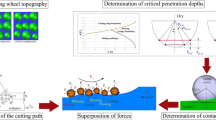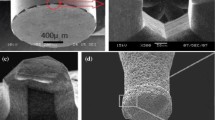Abstract
Micro-grinding using micro-tools has become very prevalent due to the miniaturization of products with increased process requirements. Moreover, this process provides an edge over other competitive processes, especially as a final process step. The quality of the part produced by the micro-scale grinding process can be influenced by various factors, particularly by the induced mechanical forces. Therefore, predictive model of cutting force can provide guidance for further development and optimization of the process. Although there has been a lot of a research conducted on conventional grinding, little knowledge has been accumulated on micro-scale grinding due to the fact that it is an emerging field of research. The early grinding models developed are mostly based on parameters such as wheel and workpiece velocity, depth of cut and grit size of the grinding wheel. Those early models narrated that the grits penetrate and cut the material from the workpiece surface with the generated grinding forces proportional to the removed material. However, those models may not be appropriate for micro-scale grinding due to the mode of material removal and the method of contact between surfaces which is different from the macro-scale method. In addition to that, due to the small feed rate used in brittle material machining, ploughing force needs to be considered intensively in addition to the chip formation force. Therefore, a new analytical model has been proposed to evaluate cutting forces of micro-grinding process based on the process configuration, workpiece material properties and micro-grinding tool topography. The size effect of micro-machining has been carefully considered in this proposed model. Therefore, this approach allows the derivation of cutting force comprising of both the chip formation force and ploughing force. Experimental investigation in a micro-grinding configuration has been pursued to validate the proposed predictive model. The estimated cutting force showed a good correlation with the experimental values except for higher depth of cut and lower feed rate. Additionally, paired T test has been performed to quantify the difference between the predicted and experimental results.
Similar content being viewed by others
References
Nguyen TA, Butler DL (2005) Simulation of precision grinding process, part 1: generation of the grinding wheel surface. Int J Mach Tools Manuf 45:1321–1328
Tonshoff HK, Peters J, Inasaki I, Paul T (1992) Modeling and simulation of grinding processes. Annals CIRP 4:677–688
Badger JA, Torrance AA (2000) A comparison of two models to predict grinding forces from wheel surface topography. Intl J Mach Tools Manuf 40(8):1099–1120
Zhang B, Wang J, Yang F, Zhu Z (1999) The effect of machine stiffness on grinding silicon nitride. Int J Adv Manuf Techn 39:1263–1283
Malkin S, Cook NH (1971) The wear of grinding wheel: part 1—attritious wear. Trans ASME J Eng Ind Ser B93:1120–1133
Malkin S (1989) Grinding technology: theory and applications of machining with abrasives. Halsted, Chichester
Li L, Fu J (1981) Research on mathematical model of grinding force. Chine J Mech Eng 17(4):31–41
Hecker RL, Liang SY, Wu XJ (2004) Grinding force and power modeling based on chip thickness analysis. Intl J Mach Tools Manuf 33(5–6):449–459
Hahn RS, Lindsay LP (1982) Principles of grinding part 4. Surface finish, geometry, and integrity. Grinding: theory, techniques and trouble shooting. SME 22:25–35
Hahn, RS, Lindsay, RP (1982A), Principles of grinding part 1. The metal removal parameter. Grinding: theory, techniques and trouble shooting. SME, 3–10
Hahn, RS, Lindsay, RP (1982B) Principles of grinding part 2. The metal removal parameter. Grinding: theory, techniques and trouble shooting. SME, 11–17
Li K, Liao W (1997) Modeling of ceramic grinding processes part I. Number of cutting points and grinding forces per grit. J Mat Proces Tech 65:1–10
Kopalinsky EM, Oxley PLB (1984) Size effects in metal removal processes. In: Third Oxford conference on mechanical properties at high rates of strain, Oxford, UK, pp 389–396
Shaw MC (2003) The size effect in metal cutting. Sadhana Indian Acad Sci 28:875–896
Hecker RL, Ramoneda IM, Liang SY (2003) Analysis of wheel topography and grit force for grinding process modeling. J Manuf Proc 5:13–23
Shaw MC (1996) Principles of abrasive processing. Clarendon, Oxford
Verkerk J, Peters J (1977) Final report concerning CIRP cooperative work on the characterization of grinding wheel topography. Ann CIRP 26:385–395
Srihari G, Lal GK (1994) Mechanics of vertical surface grinding. J Mat Proces Tech 44:14–28
Basuray PK, Misra BK, Lal GK (1977) Transition from ploughing to cutting during machining with blunt tools. Wear 43:341–349
Park HW, Liang SY (2009) Force modeling of microscale grinding process incorporating thermal effects. Int J Adv Manuf Techn 44(5–6):476–486
Liu K, Li XP (2001) Modeling of ductile cutting of tungsten carbide. Trans NAMRI/SME 29:251–258
Son SM, Lim HS, Ahn JH (2005) Effects of the friction coefficient on the minimum cutting thickness in micro cutting. Int J Mach Tools Manuf 45(4–5):529–535
Shaw, MC (1972) Fundamentals of grinding. In: Proc of the int’1 grinding conf. on new developments in grinding, Pittsburgh, PA, April, pp 221–258
Goddard J, Wilman H (1962) A theory of friction and wear during the abrasion of metals. Wear 5:114–135
Sin H, Saka N, Suh NP (1979) Abrasive wear mechanisms and the grit size effect. Wear 55:163–190
Merchant ME (1945) Mechanics of metal cutting process, and type 2 chip. J Appl Phys 16:318–324
Author information
Authors and Affiliations
Corresponding author
Rights and permissions
About this article
Cite this article
Perveen, A., Rahman, M. & Wong, Y.S. Modeling and simulation of cutting forces generated during vertical micro-grinding. Int J Adv Manuf Technol 71, 1539–1548 (2014). https://doi.org/10.1007/s00170-013-5572-y
Received:
Accepted:
Published:
Issue Date:
DOI: https://doi.org/10.1007/s00170-013-5572-y




